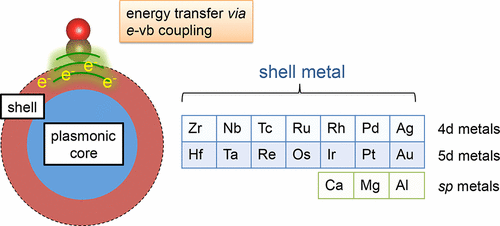当前位置:
X-MOL 学术
›
ACS Catal.
›
论文详情
Our official English website, www.x-mol.net, welcomes your
feedback! (Note: you will need to create a separate account there.)
Tailoring Energy Transfer from Hot Electrons to Adsorbate Vibrations for Plasmon-Enhanced Catalysis
ACS Catalysis ( IF 11.3 ) Pub Date : 2017-11-07 00:00:00 , DOI: 10.1021/acscatal.7b03174 Priyank V. Kumar 1 , David J. Norris 1
ACS Catalysis ( IF 11.3 ) Pub Date : 2017-11-07 00:00:00 , DOI: 10.1021/acscatal.7b03174 Priyank V. Kumar 1 , David J. Norris 1
Affiliation

|
Chemical reactions can be enhanced on surfaces of bimetallic nanoparticles composed of a core plasmonic metal and a catalytically active shell when illuminated with light. However, the atomic-level details of the steps that govern such photochemical reactions are not yet understood. One critical process is the non-adiabatic energy transfer from hot electrons that transiently populate the unoccupied electronic orbitals of the adsorbate to the vibrational modes of the adsorbed reactants. This occurs via electron–vibration coupling and could potentially be tailored by changing the composition of the shell. Here, we apply an ab initio method based on density functional theory to investigate this coupling at various sp- and d-band metal–adsorbate interfaces. Our calculations demonstrate the importance of d-bands in enhancing and tuning this energy transfer at the interface. Further, they highlight specific choices of metals that could be utilized as shells for efficient photochemical reactions. From these calculations, we extract a simple descriptor (dependent on the coupling matrix element and equilibrium bond length) that can account for the coupling strength at a metal–adsorbate interface, thus representing a valuable tool for rational shell design for different reactions. We show the utility of this descriptor for photocatalysis with calculations for a specific photochemical reaction. The introduction of this descriptor should also impact other processes such as light-triggered drug release that exploit hot electrons, and surface-enhanced Raman spectroscopy, where electron–vibration coupling plays a key role.
中文翻译:

量身定制从热电子到吸附剂振动的能量转移,以用于等离激元增强催化
当用光照射时,可以在由核心等离激元金属和催化活性壳组成的双金属纳米颗粒的表面上增强化学反应。但是,尚不了解控制此类光化学反应的步骤的原子级细节。一个关键过程是来自热电子的非绝热能量转移,该热电子瞬时将被吸附物的未被占据的电子轨道填充到被吸附反应物的振动模式中。这是通过电子-振动耦合发生的,并且可能通过更改外壳的成分进行定制。在这里,我们从头开始基于密度泛函理论的方法研究了在各种sp和d波段金属-吸附物界面的这种耦合。我们的计算证明了d波段在增强和调整界面能量传递方面的重要性。此外,它们突出显示了可以用作有效光化学反应的外壳的金属的特定选择。从这些计算中,我们提取出一个简单的描述符(取决于偶联基质元素和平衡键的长度),该描述符可以解释金属-吸附质界面的偶联强度,从而为针对不同反应进行合理的壳设计提供了有价值的工具。我们通过计算特定的光化学反应,显示了该描述符在光催化中的效用。
更新日期:2017-11-08
中文翻译:

量身定制从热电子到吸附剂振动的能量转移,以用于等离激元增强催化
当用光照射时,可以在由核心等离激元金属和催化活性壳组成的双金属纳米颗粒的表面上增强化学反应。但是,尚不了解控制此类光化学反应的步骤的原子级细节。一个关键过程是来自热电子的非绝热能量转移,该热电子瞬时将被吸附物的未被占据的电子轨道填充到被吸附反应物的振动模式中。这是通过电子-振动耦合发生的,并且可能通过更改外壳的成分进行定制。在这里,我们从头开始基于密度泛函理论的方法研究了在各种sp和d波段金属-吸附物界面的这种耦合。我们的计算证明了d波段在增强和调整界面能量传递方面的重要性。此外,它们突出显示了可以用作有效光化学反应的外壳的金属的特定选择。从这些计算中,我们提取出一个简单的描述符(取决于偶联基质元素和平衡键的长度),该描述符可以解释金属-吸附质界面的偶联强度,从而为针对不同反应进行合理的壳设计提供了有价值的工具。我们通过计算特定的光化学反应,显示了该描述符在光催化中的效用。











































 京公网安备 11010802027423号
京公网安备 11010802027423号